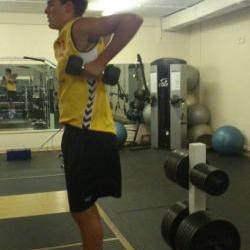Strength and conditioning for basketball: some thoughts.
If you think that basketball conditioning should resemble a scene from Coach Carter with repeated running in straight lines, you might be mistaken.
 I am lucky enough to train some good young basketball players. Most of them arrive with some sort of work ethic and overall athleticism.
I am lucky enough to train some good young basketball players. Most of them arrive with some sort of work ethic and overall athleticism.
More than a lot of sports, they understand the need for work capacity, speed and the ability to jump. They come
from (or gravitate towards) training environments that encourage repeated
efforts and work capacity.
But is there too much of a good thing?
Once the basics have
been achieved, will just doing more “stuff” help the player, or potentially hinder them? I am trying to work with the players and their coaches on looking at more efficient ways of developing fitness that more resembles the demands and needs of the game and their positions.
What are the positions?
A recap on positions for those unfamiliar with the game.
- Point guard: the general / organiser
- Shooting guard: they shoot a lot
- Small forward: good shooters, especially at free throws as
they draw a lot of attention - Power forward: very assertive player, dominant in close
quarters. - Centre: good at jumping, high skill level
Whilst everyone has to be able to do everything, the positions do have differing demands. When looking at the physical characteristics of the positions, the game might develop people into those athletes, or certain types of athlete gravitate to those positions.
Physical characteristics
Centres and power forwards are the heaviest and tallest. They need the greatest mass due to the contact at box outs, picks and rebounds. They need great lower body strength due to prolonged periods of play in the low post/ middle post position.
Point guards have to be the fittest endurance wise due to their versatility in play. Guards and forwards are only in static positions for 27%/ 28% of the time in a match. Conversely, Centres have been shown to only move linearly for 33% of the match, the rest is more lateral shuffling movements, checking, contact and such like.
So we can see a difference between the needs of the positions already. As the playing ability goes up, so do the demands of the game as decision making and tactics affects movement demands.
At International level, players do a lot more high intensity work (above 90% of max Heart Rate) but also a lot more low level work such as shuffling, to recover. The high intensity work is not just running; more body contact requires more static / isometric strength work and moving from this to running is fatiguing as inertia has to be repeatedly overcome.
The nature of the International matches has been shown to be much more intermittent in nature than National Level matches where the players did not work at such high intensities. National level players spent much more time in a “middle zone” of intensity.
How Can I get fit for basketball?
 This is the bottom line question that I am often asked. As you can see, there is more to basketball than just shuttle runs.
This is the bottom line question that I am often asked. As you can see, there is more to basketball than just shuttle runs.
If your training consists of repeated bleep tests and suicides, you are getting ready to play mid-level basketball as a guard or forward.
If you want to play at a higher level, you need to adapt your training accordingly.
I always follow this simple hierarchy of training:
1 the person
2 The athlete
3 The position.
Trying to train position specific before addressing the individual needs of the person, then their athleticism is a short cut that will come back to haunt you.
So the priorities are:
1 An overall sound movement pattern with no asymmetries.
This includes the ability to run, jump, skip, land and move sideways. Then the ability to reproduce this repeatedly must be developed.
2 Look to load these movements and progress to acceleration drills, deceleration drills and single leg work.
3 Look at position work: with centres needing strength training
that includes volume to allow an increase in mass. This strength work should be combined with movement patterns that encourage a low centre of gravity and multiple changes of direction in a small area. Guards and forwards can do more repeated jump work combined with high intensity shuttle runs.
There is a place for testing basketball fitness, I prefer one of the yo-yo tests, plus vertical jump, plus our athletic screening.
Whilst every young player asks “How can I improve my vertical?” and proceeds to show me an Internet “Jump programme”, I emphasise the need for points 1 and 2 first. As they all practice lay ups and dunks at every opportunity, the priority is for teaching landing techniques and developing strength. The application of this will come through training initially, then specifics later.
A sure way to detrain the athleticism of your basketball team is to do long slow runs, back to back bleep tests and upper body weights only.
The players pictured are Sean Clifford (SWT and Excelsior client) who has been made Captain of the Leeds University team and Harry Turner (Millfield school) who played for England -Under 18s this summer.

I agree it is very important to have the ability to perform the basic movements properly before loading to avoid injury.
Also, as a player who’s been injured for 2 years because of a coach carter type “fitness” programme it is nice to see a different viewpoint on strength and conditioning in basketball.